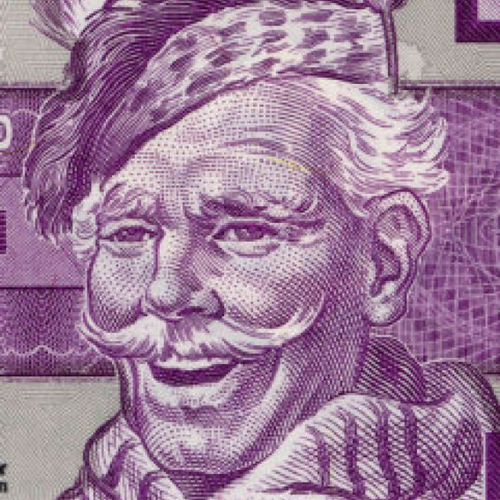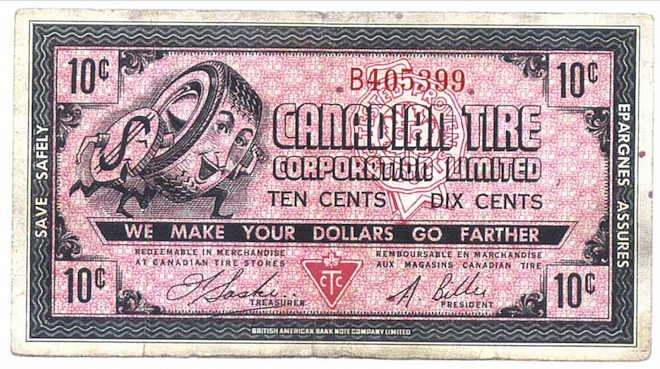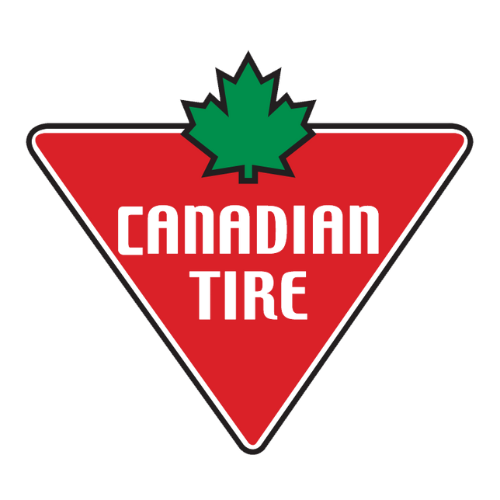Last updated on September 1st, 2025 at 11:19 am
Last Updated on September 1, 2025 Posted by Colonial Acres Coins
Over the years when you made purchases at a local Canadian Tire store, you would receive coupons in the form of Canadian Tire money redeemable for in-store purchases. Canadian Tire money is recognizable by its bright colours and the popular images of Sandy McTire, the tam-wearing Scotsman. Though the denominations are smaller, it closely resembles Canadian paper money in many respects. At one point, Canadian Tire money was even printed on similar stock. As a Canadian institution since 1958, it is sometimes viewed as the country’s unofficial second currency.
At Canadian Tire stores, the coupons are worth their face value. However, there are instances in recent years of people selling rare Canadian Tire bills for thousands of dollars. To find out more about collecting Canadian Tire money we highlight some iconic and memorable facts about this unique paper money.
HOW DID CANADIAN TIRE MONEY COME ABOUT?
The Canadian Tire Corporation was founded in 1922 by brothers John William Billes and Alfred Jackson Billes. It opened its first gas bar in 1958, at a time when many gas companies were making promotional giveaways. The idea for the Canadian Tire money came from Alfred’s wife, Muriel, who suggested it as an incentive to get people to keep coming back and purchasing more. The popularity of Canadian Tire money took off, and to this day, it is the oldest customer loyalty program in Canada.
Who Are the Billes Family?
In 2015, members of the Billes family received the Retail Council of Canada’s Lifetime Achievement Award for nearly 100 years of corporate success and commitment to their community. Their mom-and-pop tire store opened its doors in 1922. What they started 100 years ago still has a lasting legacy today.
Martha Billes is the daughter of founder A.J. Billes. Martha founded a very successful charity called Jumpstart. Each year, the company identifies families that are struggling financially and provides scholarships so that their children can participate in organized sports and outdoor play. Jumpstart’s contributions total more than $25 million per year.
Who Is Sandy McTire?
 A fictional caricature of a budget-conscious Scotsman, Sandy McTire’s face was famously printed on old Canadian tire money for decades. He was designed to represent the hardworking everyman of the 1950s. His iconic smile, waxed handlebar mustache, and traditional felt hat and scarf combination create comforting memories for many Canadians. Throughout the 20th century, it was very common for Canadian Tire money to be kept in cupboards and glove boxes. Sandy McTire became a household icon.
A fictional caricature of a budget-conscious Scotsman, Sandy McTire’s face was famously printed on old Canadian tire money for decades. He was designed to represent the hardworking everyman of the 1950s. His iconic smile, waxed handlebar mustache, and traditional felt hat and scarf combination create comforting memories for many Canadians. Throughout the 20th century, it was very common for Canadian Tire money to be kept in cupboards and glove boxes. Sandy McTire became a household icon.
When Did the Canadian Tire Money Program Start?
In 1958, after 35 years of being in business for tires and accessories only, A.J. Billes and his wife Muriel founded their first gas bar. Most competitors at the time were advertising low fuel prices. Muriel thought they could stand out from the crowd by offering customers a reason to come back to their particular store. Each time someone came into the store and made a purchase, they would receive coupons as discounts on their next purchase. This ended up becoming the most successful customer loyalty program in Canadian history.
How Do I Determine Canadian Tire Money Value?
If you’re trying to cash in on a Canadian Tire bill as a potential collector’s item, the first step is to figure out how old the bill is. The longer ago it was printed, the more it may be worth to a collector. You can also contact the Canadian Tire Collector’s Club, which publishes a collector’s guide. This spiral manual gives clear tips and detailed indicators of how much your Tire money may be worth.
For trying to figure out how much retail savings you can earn by shopping at Canadian Tire, there are calculators online which will help you input how much you spent pre-tax and how much the reward multipliers will be. This will help you know how much cash back you are entitled to.
HOW CAN YOU TELL IF CANADIAN TIRE MONEY IS WORTH SOMETHING?
While most people across the country have some Canadian Tire money in their possession, a handful actively seek it out. The Canadian Tire Money Collectors Club has about 250 members who have spent over 30 years preserving, trading, and cataloguing Canadian Tire money.
- Because Canadian Tire money is so prevalent, only certain specimens are valuable as collector’s items. The oldest bills of Canadian Tire money are rarer, so tend to be worth a lot more. For example, you could get $1,500 for a 50-cent note issued in 1958.
- Errors in printing can also increase the value of a Canadian Tire note. Examples include alterations to the appearance of the Sandy McTire mascot and serial numbers that don’t match or that print the digits too close together. One such anomalous $2 bill sold at auction in 2017 for $3,000.
- Because the Canadian Tire Money Collectors Club has catalogued the faux currency, there is a record of the highest and lowest serial numbers for each denomination. Some collectors specifically seek out these “highs and lows,” and may be willing to pay top dollar for them.
- Another area of interest for Canadian Tire money collectors is replacement notes. Sometimes a series of bills becomes damaged during printing. Replacement notes are then issued in their stead. “New replacement notes” was the topic of a talk by the club’s membership at one of their recent annual week-long swap meets.
What Do I Do With Old Canadian Tire Money?
Carefully inspect your bills to see if they have any unique qualities. Anything rare or unusual means the bill might be worth something to a collector or clearinghouse. If the two serial numbers are printed differently, or if Sandy McTire’s likeness is distinct in any way from most other bills, you might have a valuable piece in your hands. Then you could try to sell it online, or at a local antiques or currency dealer, like Colonial. Check for any blemishes, stains, corner frays, or tears, as these will affect the resale value of your tire money. The closer to mint condition, the more valuable it is.
Can You Still Use Paper Canadian Tire Money? Is Canadian Tire Money Still Good?
The future of Canadian Tire money appears uncertain. In the interest of making the rewards more trackable and more manageable, the company launched a plastic loyalty card in 2012. A digital rewards program called Triangle Rewards was launched in 2018 and seems to represent a shift away from paper coupons. The COVID-19 pandemic has also had an impact on Canadian Tire money. In an effort to control the spread of the virus, some locations have stopped accepting it.
It is unclear how much longer the company will continue producing and distributing Canadian Tire money, nor is it clear what will happen to the collector’s market if it is discontinued. In the short term, the value may increase because the bills will no longer be as prevalent. In the long term, however, interest in collecting Canadian Tire money may wane, and the value of collections may go down.
In many cases, the appeal of collecting Canadian Tire money lies in the thrill of the hunt. This is often true of collecting authentic coins and currency as well. You can find collectible bills of Canadian Tire money and real Canadian paper money for sale at Colonial Acres Coins.






